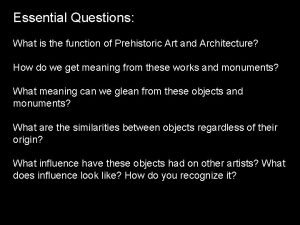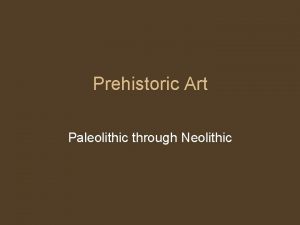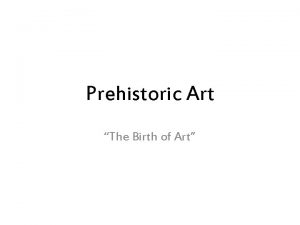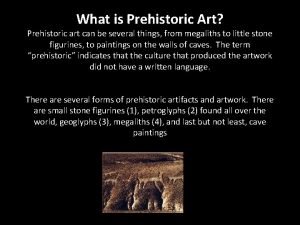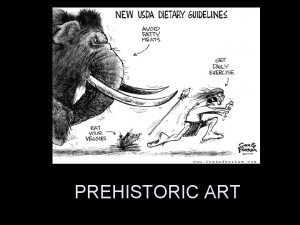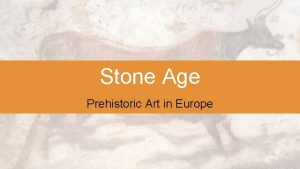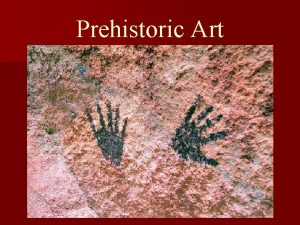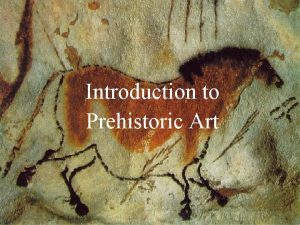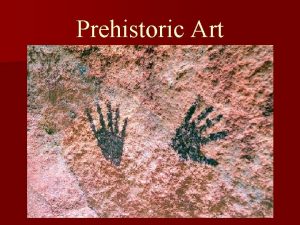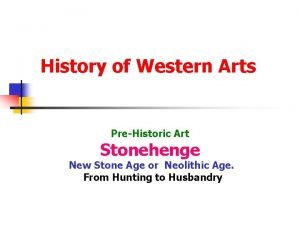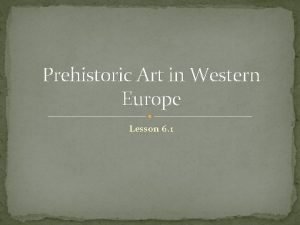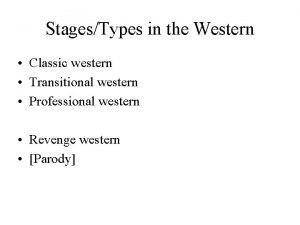PREHISTORIC ART The origins of Western Art are






























- Slides: 30

PREHISTORIC ART The origins of Western Art are unclear. The earliest forms focused around caves. This art of the Stone Age had serious purpose and may have served several functions. As their lives focused on survival, so did their art, with themes of food, shelter and fertility.

Hall of Bulls, cave paintings, Lascaux, France, 15, 000 -13, 000 BCE

Venus of Willendorf, limestone, c. 25, 000 BCE

Stonehenge, c. 2000 BCE, England

Between 3500 and 3000 BCE, a great civilization was born in Mesopotamia. Gods and rulers became central to the creation of art as each city-state had its own god and human ruler. Their temples, built out of mud brick called Ziggurats, strived to reach the gods. The biblical Tower of Babel was one such structure.

Ziggurat at Ur, c. 2100 -2000 BCE, Iraq

Because Egyptian civilization developed out of the fertile Nile Valley, Egyptians had time to focus on the arts and sciences. Survival was no longer their only goal. Due to their relative geographic isolation, Egyptian art and culture remained constant for several thousand years. Their strong belief in an afterlife helped stimulate the growth of all art forms, including the construction of pyramids.

The Great Pyramids, c. 2530 -2470 BCE Giza

Great Pyramids, construction

The Great Sphinx, c. BCE 2500, Giza, limestone

Mycerinus and his Queen, BCE 25482530, slate

Egypt’s Old Kingdom was followed by the powerful rulers of the New Kingdom. Architecture shifted to funerary temples. Artists and craftspeople continued to hold respected positions. The New Kingdom is considered to be the Golden Age of Egypt’s history. Many artefacts remain. Papyrus was used to draw stories. Humans depicted in registers, in half profile poses and gods are shown as animals. Descriptive perspective means that important figures were depicted larger than less important ones. Greenfield papyrus c. BCE 1080

Queen Nefertiti, c. BCE 1360, painted limestone

While the civilization in Egypt was flourishing, two others developed along the Aegean Sea: one on the island of Crete, the other on mainland Greece. The Minoans in Crete were very rich and had several palace centres decorated with images of the pleasures of life. The Mycenaeans on the mainland were warriors more than they were traders and had monuments reflecting a protected environment.

CRETE Bull Dance, from the Palace of Knossos, Crete, 1500 BCE, fresco

The human being was placed at the centre of Greek culture. They encouraged all forms of art, their key ideals being proportion, balance and unity. The human body was considered to be beautiful and perfectly proportioned.

archaic Kouros, 600 BCE, marble classic Kritios Boy, c. 480 BCE, marble

Nike of Samothrace, c. 190 BCE, marble hellenistic

DORIC The classical orders of architecture consisted of detailed rules for construction. These were based on proportions and an integration of the parts of the buildings. IONIC CORINTHIAN http: //www. flickr. com/photos/panjer/4305959870/

The Parthenon, Iktinos and Kallikrates, 448432 BCE, The Acropolis, Athens

Artist’s reconstruction of the original Acropolis in Athens.

Water jar with the infant Herakles strangling snakes sent by the goddess Hera. Red Figure Kalpis, attributed to the Nausicaä Painter, ca 460 -450 BCE, Greece Water jug with Poseidon killing Polybotes by dropping the island of Nisyros on him. Black Figure Amphora, Workshop of Exekias, 530 BCE, Greece

The Roman city-state had its first beginnings in the 8 th century BCE. Their civilization began to dominate the western world. The Romans excelled in the art of architecture but often borrowed from and imitated the Greeks.

marvels of engineering The Arch of Constantine, 312 -315 CE, Rome

the arch principle: 1 = keystone

Roman aqueduct in Segovia The Colosseum, 72 -80 CE, Rome

The Pantheon, 118 -125 CE, Rome

Model of the Pantheon Floorplan and segmented views of the Pantheon

Roman Bust, mid 1 st century CE, marble

Woman playing a cithara, c. 79 CE fresco
 Mikael ferm
Mikael ferm Ancient art 1 500 00 bc-2 000bc
Ancient art 1 500 00 bc-2 000bc Prehistoric art notes
Prehistoric art notes Function of prehistoric
Function of prehistoric Prehistoric era
Prehistoric era Prehistoric horse
Prehistoric horse Prehistory timeline
Prehistory timeline Prehistoric
Prehistoric The medicine of prehistoric people
The medicine of prehistoric people Prehistoric era
Prehistoric era Prehistoric medicine
Prehistoric medicine First xray ever taken
First xray ever taken Prehistoric
Prehistoric Prehistoric tasmanian devil
Prehistoric tasmanian devil Georgia's prehistoric cultures chart
Georgia's prehistoric cultures chart Prehistoric lemur
Prehistoric lemur Prehistoric monument dan word
Prehistoric monument dan word Dolmen meaning
Dolmen meaning Western gothic art
Western gothic art Công thức tiính động năng
Công thức tiính động năng 101012 bằng
101012 bằng Tỉ lệ cơ thể trẻ em
Tỉ lệ cơ thể trẻ em Lời thề hippocrates
Lời thề hippocrates Vẽ hình chiếu đứng bằng cạnh của vật thể
Vẽ hình chiếu đứng bằng cạnh của vật thể đại từ thay thế
đại từ thay thế Quá trình desamine hóa có thể tạo ra
Quá trình desamine hóa có thể tạo ra Kể tên các môn thể thao
Kể tên các môn thể thao Khi nào hổ mẹ dạy hổ con săn mồi
Khi nào hổ mẹ dạy hổ con săn mồi Thế nào là mạng điện lắp đặt kiểu nổi
Thế nào là mạng điện lắp đặt kiểu nổi Hình ảnh bộ gõ cơ thể búng tay
Hình ảnh bộ gõ cơ thể búng tay Dot
Dot



